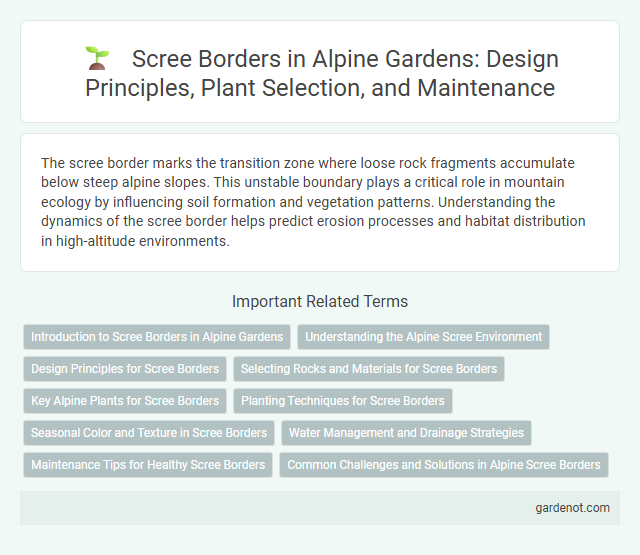The scree border marks the transition zone where loose rock fragments accumulate below steep alpine slopes. This unstable boundary plays a critical role in mountain ecology by influencing soil formation and vegetation patterns. Understanding the dynamics of the scree border helps predict erosion processes and habitat distribution in high-altitude environments.
Introduction to Scree Borders in Alpine Gardens
Scree borders in Alpine gardens replicate natural rocky slopes, providing ideal drainage and microclimates for alpine plants to thrive. These borders consist of loose stones and gravel that create a porous substrate, preventing waterlogging while supporting species like Saxifraga and Sedum. Incorporating scree borders enhances visual authenticity and promotes biodiversity by mimicking native alpine habitats.
Understanding the Alpine Scree Environment
The Alpine scree environment features loose rock debris accumulating along steep mountain slopes, influenced by freeze-thaw weathering and gravity-driven processes. Scree borders mark the transition zones between stable bedrock and unstable talus fields, where microhabitats support specialized flora and fauna adapted to harsh conditions. Understanding these dynamic interfaces is essential for assessing alpine geomorphology, biodiversity, and climate change impacts in high-altitude ecosystems.
Design Principles for Scree Borders
Scree borders utilize a combination of angular stones and gravel to promote drainage and mimic natural alpine environments, enhancing plant resilience and growth. Design principles emphasize layering materials to ensure stability while allowing root expansion, integrating drought-tolerant and low-maintenance alpine species. Proper gradient and stone size distribution further support erosion control and aesthetic harmony in alpine scree landscaping.
Selecting Rocks and Materials for Scree Borders
Scree borders require selecting angular, durable rocks such as granite or basalt to ensure long-lasting stability and effective drainage. Properly sized stones ranging from 2 to 10 inches prevent soil erosion while promoting natural water flow through the scree. Using locally sourced materials enhances ecological compatibility and reduces environmental impact.
Key Alpine Plants for Scree Borders
Key alpine plants for scree borders include Saxifraga oppositifolia, which thrives in well-drained, rocky soils, and Silene acaulis, known for its dense, cushion-like mats that stabilize loose scree. Draba spp. and Androsace septentrionalis are also vital, as they adapt to harsh alpine conditions, providing both erosion control and vibrant seasonal blooms. These species contribute to biodiversity while maintaining the structural integrity of scree environments in high-altitude gardens.
Planting Techniques for Scree Borders
Effective planting techniques for scree borders in alpine environments emphasize the use of well-drained, gritty soils to mimic natural scree conditions. Selecting drought-tolerant, mat-forming alpine plants such as Saxifraga, Sempervivum, and Sedum ensures resilience and vibrant growth. Strategic placement of plants in crevices and between rocks enhances root stability and replicates natural scree ecosystems, promoting sustainable plant development.
Seasonal Color and Texture in Scree Borders
Scree borders exhibit a dynamic seasonal color palette, ranging from vibrant alpine wildflowers in spring to earthy browns and grays as plants senesce in autumn. Texture varies significantly with seasonal moisture levels, shifting from soft mossy cushions and lush herbaceous growth during wetter months to coarse, loose rock and dry lichen surfaces in drier periods. These seasonal changes in color and texture contribute to the unique ecological niche and visual diversity of alpine scree environments.
Water Management and Drainage Strategies
Scree borders play a crucial role in alpine water management by influencing natural drainage patterns and reducing soil erosion on steep slopes. Effective drainage strategies involve channeling meltwater and rainfall through engineered swales or permeable barriers to prevent water accumulation and slope destabilization. Integrating these techniques supports ecosystem stability while mitigating flood risks in mountainous terrains.
Maintenance Tips for Healthy Scree Borders
Maintaining healthy Alpine scree borders requires regular removal of invasive species to preserve native flora and ensure proper drainage, preventing waterlogging that can damage root systems. Applying mulch with sharp, angular stones mimics natural scree conditions, enhancing soil aeration and temperature regulation vital for scree-adapted plants. Periodic inspection for erosion or stone displacement helps maintain structural integrity, supporting biodiversity and stabilizing the scree ecosystem.
Common Challenges and Solutions in Alpine Scree Borders
Common challenges in Alpine scree borders include soil instability, extreme weather fluctuations, and limited vegetation growth due to rapid drainage and shifting substrates. Effective solutions involve using engineered barriers to prevent erosion, introducing hardy native plant species to stabilize soil, and employing geotextiles to enhance substrate cohesion and reduce movement. Monitoring environmental changes and adaptive management further support the resilience of these fragile border ecosystems.
Scree border Infographic

 gardenot.com
gardenot.com